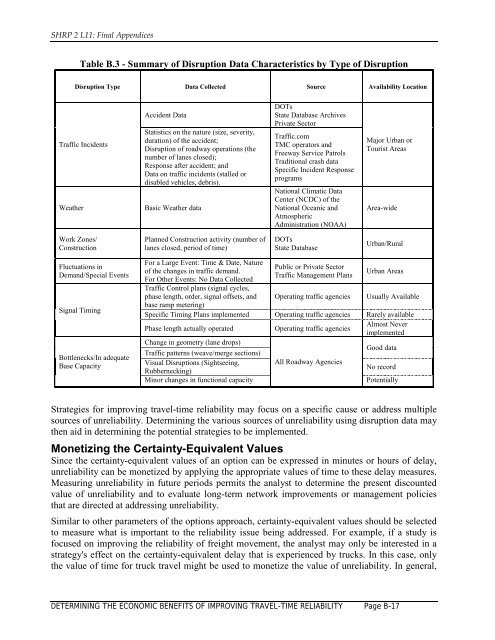Evaluating Alternative Operations Strategies to Improve Travel Time ...
Evaluating Alternative Operations Strategies to Improve Travel Time ...
Evaluating Alternative Operations Strategies to Improve Travel Time ...
You also want an ePaper? Increase the reach of your titles
YUMPU automatically turns print PDFs into web optimized ePapers that Google loves.
SHRP 2 L11: Final Appendices<br />
Table B.3 - Summary of Disruption Data Characteristics by Type of Disruption<br />
Disruption Type Data Collected Source Availability Location<br />
Traffic Incidents<br />
Weather<br />
Accident Data<br />
Statistics on the nature (size, severity,<br />
duration) of the accident;<br />
Disruption of roadway operations (the<br />
number of lanes closed);<br />
Response after accident; and<br />
Data on traffic incidents (stalled or<br />
disabled vehicles, debris).<br />
Basic Weather data<br />
DOTs<br />
State Database Archives<br />
Private Sec<strong>to</strong>r<br />
Traffic.com<br />
TMC opera<strong>to</strong>rs and<br />
Freeway Service Patrols<br />
Traditional crash data<br />
Specific Incident Response<br />
programs<br />
National Climatic Data<br />
Center (NCDC) of the<br />
National Oceanic and<br />
Atmospheric<br />
Administration (NOAA)<br />
Major Urban or<br />
Tourist Areas<br />
Area-wide<br />
Work Zones/<br />
Construction<br />
Planned Construction activity (number of<br />
lanes closed, period of time)<br />
DOTs<br />
State Database<br />
Urban/Rural<br />
Fluctuations in<br />
Demand/Special Events<br />
Signal Timing<br />
Bottlenecks/In adequate<br />
Base Capacity<br />
For a Large Event: <strong>Time</strong> & Date, Nature<br />
of the changes in traffic demand.<br />
For Other Events: No Data Collected<br />
Traffic Control plans (signal cycles,<br />
phase length, order, signal offsets, and<br />
base ramp metering)<br />
Public or Private Sec<strong>to</strong>r<br />
Traffic Management Plans<br />
Operating traffic agencies<br />
Urban Areas<br />
Usually Available<br />
Specific Timing Plans implemented Operating traffic agencies Rarely available<br />
Phase length actually operated<br />
Operating traffic agencies<br />
Almost Never<br />
implemented<br />
Change in geometry (lane drops)<br />
Traffic patterns (weave/merge sections)<br />
Good data<br />
Visual Disruptions (Sightseeing, All Roadway Agencies<br />
Rubbernecking)<br />
No record<br />
Minor changes in functional capacity<br />
Potentially<br />
<strong>Strategies</strong> for improving travel-time reliability may focus on a specific cause or address multiple<br />
sources of unreliability. Determining the various sources of unreliability using disruption data may<br />
then aid in determining the potential strategies <strong>to</strong> be implemented.<br />
Monetizing the Certainty-Equivalent Values<br />
Since the certainty-equivalent values of an option can be expressed in minutes or hours of delay,<br />
unreliability can be monetized by applying the appropriate values of time <strong>to</strong> these delay measures.<br />
Measuring unreliability in future periods permits the analyst <strong>to</strong> determine the present discounted<br />
value of unreliability and <strong>to</strong> evaluate long-term network improvements or management policies<br />
that are directed at addressing unreliability.<br />
Similar <strong>to</strong> other parameters of the options approach, certainty-equivalent values should be selected<br />
<strong>to</strong> measure what is important <strong>to</strong> the reliability issue being addressed. For example, if a study is<br />
focused on improving the reliability of freight movement, the analyst may only be interested in a<br />
strategy's effect on the certainty-equivalent delay that is experienced by trucks. In this case, only<br />
the value of time for truck travel might be used <strong>to</strong> monetize the value of unreliability. In general,<br />
DETERMINING THE ECONOMIC BENEFITS OF IMPROVING TRAVEL-TIME RELIABILITY Page B-17















